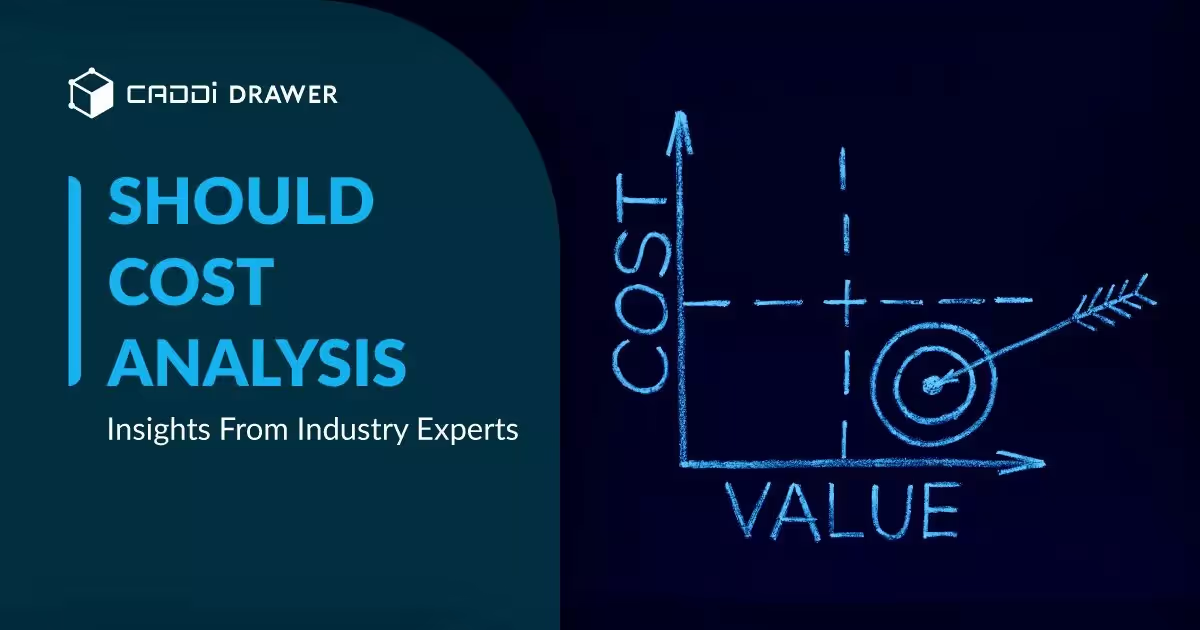The Procurement Playbook: 12 Actionable Strategies to Reduce Manufacturing Supply Chain Costs in 2025

Table of Contents

In today's dynamic manufacturing landscape, leaders are grappling with intense pressures, including escalating operational costs, supply chain disruptions, and skilled labor shortages. Rising costs are consistently cited as a top concern for manufacturing CEOs. While these challenges can feel overwhelming, they also present a crucial opportunity to redefine operational strategies and drive substantial cost savings. The good news is that significant opportunities for cost reduction exist within data-based processes like design and procurement, areas often overlooked after initial optimizations have been made in manufacturing itself.
Understanding the Challenge: Why is Cost Reduction So Hard?
For many manufacturing companies, the path to cost reduction is often hindered by fragmented data and inefficient processes. Data silos, where information is isolated within departments, lead to inconsistencies and impede crucial cross-functional collaboration. For example, quality data for a part might reside in a Product Lifecycle Management (PLM) system, while procurement data is kept in an Enterprise Resource Planning (ERP) system. This lack of integration makes it difficult for teams to get a unified view of operations and can delay decision-making processes.
The consequences are tangible: a significant number of procurement professionals (60%) report sourcing parts at higher costs than necessary due to insufficient supplier data for effective negotiation. Similarly, 71% of sales professionals have quoted or sold unprofitable deals because they lacked access to historical engineering and procurement data. This demonstrates a clear need for a more comprehensive and insightful digital system to bridge these "data gaps".
The Procurement Playbook: Actionable Strategies
To effectively address rising costs and enhance profitability, procurement teams can implement a multi-faceted playbook. Here are 11 actionable strategies, culminating in a powerful, data-driven approach:
- 1. Renegotiate Contracts: Leverage performance metrics and historical data to push for improved terms with underperforming suppliers on pricing, quality, or delivery times.
- 2. Implement Design for Manufacturability (DFM): Integrate manufacturing process considerations into the engineering phase to optimize production methods, reduce complexity, and minimize unnecessary costs from the outset. It is often said that 80% of a product's cost is determined by its design.
- 3. Conduct Should-Cost Analysis (SCA): This methodology enables businesses to dissect and understand the true cost of products and services, laying the groundwork for informed negotiation. SCA helps align cost management with strategic goals, leading to more transparent and data-driven dialogues with suppliers.
- 4. Optimize Inventory Levels: Employ strategies like ABC Analysis and XYZ Analysis to classify inventory based on value and demand predictability, which helps allocate resources smartly, reduce storage expenses, and enhance product lifecycle management.
- 5. Embrace Supplier Consolidation: Reduce the number of suppliers and increase order volumes with each, which can lead to stronger negotiation leverage and volume discounts. This can also provide more consistency in part quality.
- 6. Explore Supplier Diversification: While consolidation is beneficial, diversifying suppliers can spread risk and provide opportunities for better deals by exploring alternatives.
- 7. Enhance Request for Quotation (RFQ) Management: Streamline the RFQ process through speed and accuracy, utilizing organized data on past projects, pricing, and materials. Fast responses are crucial for competitive advantage.
- 8. Apply Lean Manufacturing Principles: Focus on maximizing value by minimizing waste in all production and procurement processes, including identifying and eliminating defects, overproduction, waiting, and excess inventory.
- 9. Utilize Cost Driver Analysis (CDA): Identify and quantify the key activities that drive costs across departments, allowing for targeted actions to increase efficiency and productivity.
- 10. Adopt Lifecycle Costing (LCC): Analyze the total cost of a project or asset over its entire lifespan, including acquisition, operating, maintenance, and disposal costs, to make more informed long-term decisions.
- 11. Foster Cross-Functional Collaboration: Enhance communication and shared goals between procurement, engineering, manufacturing, and sales to ensure strategic alignment and efficient problem-solving.
Leveraging Your Data to Unlock Hidden Savings
The 12th and perhaps most powerful strategy involves leveraging your own data to unlock hidden savings. Procurement teams often struggle to evaluate quotes for new parts because they lack an easy way to compare them to the historical costs of similar components. This often leads to overspending and missed savings opportunities.
This is where a centralized data platform like CADDi becomes invaluable. CADDi functions as an AI-driven data lake, consolidating information from various sources such as PLM, ERP, CAD, and even old scanned documents with handwritten notes. This allows manufacturing businesses to transform unstructured and trapped data into searchable assets.
CADDi's patented similarity search technology analyzes the shape and features of parts, enabling procurement managers to instantly find historically similar parts, analyze their cost data, and establish a data-backed benchmark for what should be paid for a new part. This transforms negotiation from an art based on relationships into a science based on data, empowering teams with undeniable leverage and helping them spot outlier quotes. For instance, Dairy Conveyor Corp. (DCC) Automation achieved a 22% reduction in fabricated part spend by using CADDi to evaluate suppliers and consolidate parts.
Furthermore, CADDi links all relevant contextual data—including purchase orders, supplier information, quality defect reports, and engineering design revisions—directly to the part drawing. This immediate access to a comprehensive history of pricing and supplier performance makes it easier for even new employees to make impactful decisions without relying on the expertise of a few seasoned individuals, addressing the issue of "tribal knowledge".
Beyond Immediate Savings: Long-Term Benefits of Data-Driven Procurement
Implementing a data-driven approach to procurement with tools like CADDi not only delivers immediate cost savings but also fosters long-term strategic advantages. It enhances cross-functional collaboration, allowing engineering, procurement, and sales teams to access shared, accurate information, leading to better and faster product development and increased speed to market. It helps businesses become more agile and resilient in the face of supply chain disruptions, enabling quick pivots to alternative suppliers and strategies when needed.
Ultimately, by building a "System of Insight" that centralizes critical information, manufacturers can move from reactive cost-cutting to a state of proactive, data-driven cost optimization. This foundational intelligence empowers innovation, improves operational efficiency, and builds a truly competitive manufacturing operation for the future.
The future belongs to those who dare to embrace change, collaborate, and harness the power of data and AI in the pursuit of excellence.
To discover how CADDi can transform your procurement processes, accelerate your workflows, and unlock hidden savings, explore our interactive product tour or book a personalized demo.
In today's dynamic manufacturing landscape, leaders are grappling with intense pressures, including escalating operational costs, supply chain disruptions, and skilled labor shortages. Rising costs are consistently cited as a top concern for manufacturing CEOs. While these challenges can feel overwhelming, they also present a crucial opportunity to redefine operational strategies and drive substantial cost savings. The good news is that significant opportunities for cost reduction exist within data-based processes like design and procurement, areas often overlooked after initial optimizations have been made in manufacturing itself.
Understanding the Challenge: Why is Cost Reduction So Hard?
For many manufacturing companies, the path to cost reduction is often hindered by fragmented data and inefficient processes. Data silos, where information is isolated within departments, lead to inconsistencies and impede crucial cross-functional collaboration. For example, quality data for a part might reside in a Product Lifecycle Management (PLM) system, while procurement data is kept in an Enterprise Resource Planning (ERP) system. This lack of integration makes it difficult for teams to get a unified view of operations and can delay decision-making processes.
The consequences are tangible: a significant number of procurement professionals (60%) report sourcing parts at higher costs than necessary due to insufficient supplier data for effective negotiation. Similarly, 71% of sales professionals have quoted or sold unprofitable deals because they lacked access to historical engineering and procurement data. This demonstrates a clear need for a more comprehensive and insightful digital system to bridge these "data gaps".
The Procurement Playbook: Actionable Strategies
To effectively address rising costs and enhance profitability, procurement teams can implement a multi-faceted playbook. Here are 11 actionable strategies, culminating in a powerful, data-driven approach:
- 1. Renegotiate Contracts: Leverage performance metrics and historical data to push for improved terms with underperforming suppliers on pricing, quality, or delivery times.
- 2. Implement Design for Manufacturability (DFM): Integrate manufacturing process considerations into the engineering phase to optimize production methods, reduce complexity, and minimize unnecessary costs from the outset. It is often said that 80% of a product's cost is determined by its design.
- 3. Conduct Should-Cost Analysis (SCA): This methodology enables businesses to dissect and understand the true cost of products and services, laying the groundwork for informed negotiation. SCA helps align cost management with strategic goals, leading to more transparent and data-driven dialogues with suppliers.
- 4. Optimize Inventory Levels: Employ strategies like ABC Analysis and XYZ Analysis to classify inventory based on value and demand predictability, which helps allocate resources smartly, reduce storage expenses, and enhance product lifecycle management.
- 5. Embrace Supplier Consolidation: Reduce the number of suppliers and increase order volumes with each, which can lead to stronger negotiation leverage and volume discounts. This can also provide more consistency in part quality.
- 6. Explore Supplier Diversification: While consolidation is beneficial, diversifying suppliers can spread risk and provide opportunities for better deals by exploring alternatives.
- 7. Enhance Request for Quotation (RFQ) Management: Streamline the RFQ process through speed and accuracy, utilizing organized data on past projects, pricing, and materials. Fast responses are crucial for competitive advantage.
- 8. Apply Lean Manufacturing Principles: Focus on maximizing value by minimizing waste in all production and procurement processes, including identifying and eliminating defects, overproduction, waiting, and excess inventory.
- 9. Utilize Cost Driver Analysis (CDA): Identify and quantify the key activities that drive costs across departments, allowing for targeted actions to increase efficiency and productivity.
- 10. Adopt Lifecycle Costing (LCC): Analyze the total cost of a project or asset over its entire lifespan, including acquisition, operating, maintenance, and disposal costs, to make more informed long-term decisions.
- 11. Foster Cross-Functional Collaboration: Enhance communication and shared goals between procurement, engineering, manufacturing, and sales to ensure strategic alignment and efficient problem-solving.
Leveraging Your Data to Unlock Hidden Savings
The 12th and perhaps most powerful strategy involves leveraging your own data to unlock hidden savings. Procurement teams often struggle to evaluate quotes for new parts because they lack an easy way to compare them to the historical costs of similar components. This often leads to overspending and missed savings opportunities.
This is where a centralized data platform like CADDi becomes invaluable. CADDi functions as an AI-driven data lake, consolidating information from various sources such as PLM, ERP, CAD, and even old scanned documents with handwritten notes. This allows manufacturing businesses to transform unstructured and trapped data into searchable assets.
CADDi's patented similarity search technology analyzes the shape and features of parts, enabling procurement managers to instantly find historically similar parts, analyze their cost data, and establish a data-backed benchmark for what should be paid for a new part. This transforms negotiation from an art based on relationships into a science based on data, empowering teams with undeniable leverage and helping them spot outlier quotes. For instance, Dairy Conveyor Corp. (DCC) Automation achieved a 22% reduction in fabricated part spend by using CADDi to evaluate suppliers and consolidate parts.
Furthermore, CADDi links all relevant contextual data—including purchase orders, supplier information, quality defect reports, and engineering design revisions—directly to the part drawing. This immediate access to a comprehensive history of pricing and supplier performance makes it easier for even new employees to make impactful decisions without relying on the expertise of a few seasoned individuals, addressing the issue of "tribal knowledge".
Beyond Immediate Savings: Long-Term Benefits of Data-Driven Procurement
Implementing a data-driven approach to procurement with tools like CADDi not only delivers immediate cost savings but also fosters long-term strategic advantages. It enhances cross-functional collaboration, allowing engineering, procurement, and sales teams to access shared, accurate information, leading to better and faster product development and increased speed to market. It helps businesses become more agile and resilient in the face of supply chain disruptions, enabling quick pivots to alternative suppliers and strategies when needed.
Ultimately, by building a "System of Insight" that centralizes critical information, manufacturers can move from reactive cost-cutting to a state of proactive, data-driven cost optimization. This foundational intelligence empowers innovation, improves operational efficiency, and builds a truly competitive manufacturing operation for the future.
The future belongs to those who dare to embrace change, collaborate, and harness the power of data and AI in the pursuit of excellence.
To discover how CADDi can transform your procurement processes, accelerate your workflows, and unlock hidden savings, explore our interactive product tour or book a personalized demo.
Ready to see CADDi Drawer in action? Get a personalized demo.
Subscribe to our Blog!
Related Resources












.svg)



.svg)
.svg)
.svg)


